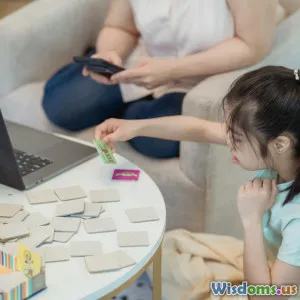
Innovations in Teaching Methods
7 min read Explore groundbreaking teaching innovations reshaping education for deeper engagement and personalized learning outcomes. (0 Reviews)
Innovations in Teaching Methods: Revolutionizing Education for the Future
Education is undergoing a dynamic transformation. Traditional lecture-based classrooms are giving way to inventive teaching methods that foster deeper understanding, creativity, and personalized learning experiences. But what fuels this revolution? From technological advancements to psychological insights, educators worldwide are pioneering new approaches to enhance student engagement and success.
Introduction: Captivating a New Generation of Learners
The rapid evolution of society and technology has altered how information is consumed and processed, especially by younger generations. Today's students, known for their digital nativity and shorter attention spans, require teaching strategies that move beyond rote memorization and passive listening. Instead, they seek interactive, meaningful learning experiences that prepare them for an unpredictable future.
As Maryanne Wolf, a reading expert, famously said, "Our brains now demand a reading experience that is more immersive, adaptive, and engaging." Similarly, educators across disciplines recognize that traditional pedagogy alone cannot meet students' diverse needs.
Body
1. Integrating Technology: More Than Just Digital Tools
The most visible innovation in modern teaching is the integration of technology within classrooms. However, technology’s true power lies beyond simple digitization of lessons. Interactive platforms such as Kahoot! and Nearpod gamify learning, increasing motivation and participation. Meanwhile, virtual reality (VR) and augmented reality (AR) invite students to explore complex concepts in immersive environments—like walking through an ancient city or examining internal human anatomy in three dimensions.
A 2019 EdTech report revealed that 85% of teachers who employed VR noticed a significant increase in student participation. Additionally, platforms that incorporate AI-driven adaptive learning, such as DreamBox and Carnegie Learning, adjust content to fit each learner’s pace and style, addressing individual strengths and weaknesses.
2. Active Learning and Collaborative Approaches
Innovations in pedagogy increasingly emphasize active learning — a shift from passively listening to actively engaging with material. Methods such as flipped classrooms encourage students to review lecture materials independently, then devote class time to group problem-solving and discussion.
Stanford University's research demonstrates that students participating in active learning classes performed 6% better on exams compared to traditional classes and were half as likely to fail. Moreover, collaboration tools like Google Workspace enable real-time group work across distances, fostering teamwork skills critical for modern workplaces.
3. Personalized and Competency-Based Learning
Recognizing that every student learns differently, educators are developing personalized approaches that tailor instruction to individual needs rather than a one-size-fits-all curriculum. Competency-based learning, for instance, allows students to progress at their own pace by demonstrating mastery over specific skills or concepts before moving forward.
For example, Summit Public Schools implement a personalized learning plan blending in-class mentorship with online modules. Their results? A 10-point improvement in graduation rates and significantly higher college acceptance rates.
4. Emotional and Social Learning Integration
An emerging but vital innovation in teaching lies in emotional and social learning (SEL), which equips students to manage emotions, set goals, and establish positive relationships. Studies from the Collaborative for Academic, Social, and Emotional Learning (CASEL) show SEL programs lead to improved attitudes, behaviors, and even an 11-percentile increase in academic performance.
Successful implementation involves classroom activities designed to develop empathy, resilience, and self-awareness. Integrating SEL fosters a supportive environment where students feel safe and motivated to take intellectual risks.
5. Gamification and Microlearning
Capitalizing on the natural human inclination toward games, gamification applies game mechanics to educational contexts. Points systems, leaderboards, and rewards encourage persistence and make challenging subjects more approachable.
Additionally, microlearning breaks complex topics into bite-sized lessons, which are easier to absorb and retain. Platforms like Duolingo excel by using gamification combined with spaced repetition techniques, contributing to millions worldwide learning new languages effectively.
6. Project-Based Learning and Real-World Connections
Project-based learning (PBL) immerses students in complex, authentic projects that require critical thinking, creativity, and collaboration. This methodology promotes deeper understanding and develops practical skills.
High Tech High in California exemplifies PBL success: students engage in interdisciplinary projects linked to community issues, resulting in increased student motivation and real-world problem-solving skills. Moreover, assessments often include presentations and portfolios, providing multifaceted evidence of mastery.
Conclusion: Embracing Innovation to Empower Tomorrow's Leaders
Innovations in teaching methods represent not just a trend but an essential evolution in education. Technologies like VR, personalized learning, active engagement strategies, SEL, and gamification collectively create richer, more inclusive learning environments.
In a world demanding agility, creativity, and empathy, educators empowered by innovative practices can vastly improve student outcomes. It is imperative for education systems globally to continue investing in and adopting these approaches to cultivate confident, competent learners ready to face future challenges.
As Nelson Mandela profoundly stated, "Education is the most powerful weapon which you can use to change the world." By innovating how we teach, we renew our commitment to that change.
Rate the Post
User Reviews
Popular Posts





















